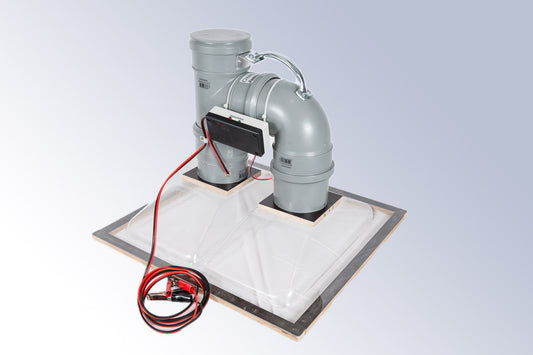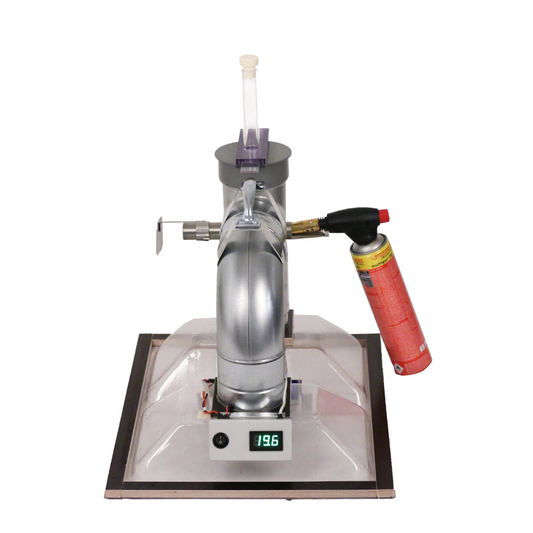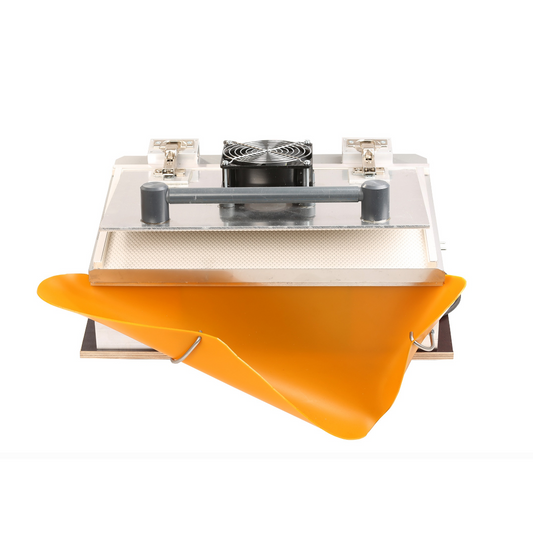Oxalic acid evaporation with the Oxamat Jumbo:
The oxamate is placed on the transparent lid. The shape of the lid divides the resulting cavity into two parts. The transparent lid prevents bees from entering the pipe system and the beekeeper can continue to observe the evaporation very well. The favorable shape of the transparent hood means that the oxalic acid vapors are not hindered in their circulation. Evaporation begins around 1 minute after starting and the oxalic acid vapors circulate through the honeycomb passages. The bees filter the remaining vapors out of the hive air in a short time as a result of the further circulation.
The evaporation time is set so that the heater switches itself off after everything has evaporated.
If oxalic acid is heated to 157°C, the water component decomposes first, and at 189°C the hydrate decomposes into oxygen, carbon monoxide and water. However, with oxamate, the oxalic acid is not overheated, which explains the excellent efficiency of almost 100%.
When used correctly, the oxalic acid fumes can be kept very well under control with this closed system. Only 0.5 to 1 gram is vaporized per treatment and all of it gets into the bees' fur through the circulating air. Around 100,000 treatments have now been carried out on bee colonies with these devices, with great success and without harm to beekeepers or bees.
If the oxamate was applied in the autumn of the previous year, after the colonies were broodless, no further treatment is necessary until the end of August. The very good effect kills almost all mites, so that the damage threshold is not reached by then.
However, if colonies in the immediate vicinity collapse due to Varroa, the Oxamate must be applied earlier. Reinvasion can bring hundreds of mites into the colony every day. Even a previously healthy colony will then be infected with several thousand mites after 14 days, meaning that it will then die from Varroa and infect other colonies.
Evaporated oxalic acid acts on the Varroa mites for almost a week, killing all Varroa mites that hatch with the bees during this time. If the treatment is repeated immediately afterwards, a renewed infection of the brood with mites can be prevented.
In August, a block treatment should be carried out on the commercial colonies three times at intervals of about four days. If fewer than 20 Varroa mites fall off after 48 hours, no further treatment is necessary until September 10th.
In the second week of September, all colonies should be treated with Oxamat. Further treatments depend on the weather conditions. During longer periods of good weather in September, October and November, the bees fly out for many hours a day, which encourages the reinvasion of Varroa mites. After 10 days of good weather, Oxamat should be applied to the strongest colonies to control the mites. If more than 200 mites fall off within 2 days of treatment, then all other colonies in the colony must also be treated. After bad weather and few bee flights, no action is necessary.
As many years of experience show, the last fumigation should be carried out in November or December. The colonies are then largely brood-free, so all Varroa mites are reached by the oxalic acid dust. At the highest level of effectiveness, the resident Varroa mites do not survive the treatment. The colonies are largely free of Varroa and go through the winter strong and healthy.
If the oxamate is used as described, no further mechanical or chemical treatment method is necessary, as this would only place unnecessary strain on the colonies.
Oxalic acid fumigation with the oxamate does not harm brood or bees, even if it is fumigated multiple times. Temperature and humidity do not affect the efficiency
We cannot provide a warranty for wearing parts such as temperature sensors, lamps or batteries.
Registered with the Patent and Trademark Office


















